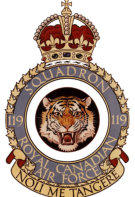Wartime Heritage
ASSOCIATION

119 Squadron (Bomber Reconnaissance) Squadron was based at RCAF Station Yarmouth
July 21, 1940, and January 10, 1942.
________________________________________
Formed on May 15, 1935, as No. 19 (Bomber) Squadron (Auxiliary) in Hamilton, Ontario, this unit began its
journey with modest training flights using 4 Moth aircraft. It was also known as the City of Hamilton Squadron.
Renumbered No. 119 Squadron in November 1937, it was mobilized for full-time service on September 3,
1939, as Canada entered the Second World War.
By July 21, 1940, the squadron was stationed at RCAF
Station Yarmouth, Nova Scotia, where it flew Bristol
Fairchild Bolingbrokes, Canadian-built versions of the
British Blenheim Mk IV bomber produced by Fairchild-
Canada. These twin-engine aircraft were vital for
maritime patrol and anti-submarine reconnaissance,
guarding Canada's eastern shores during the height of the
Battle of the Atlantic
Re-designated a Bomber Reconnaissance (BR) Squadron
on October 31st, the 119th (BR) Squadron flew from
Yarmouth NS, Sydney NS, Dartmouth NS and Mont-Joli,
Quebec on anti-submarine duty over the Gulf of St.
Lawrence and the waters adjacent to Cape Breton Island.
One of the squadron’s notable missions was the escort of
HMS Ramillies through the Bay of Fundy in March 1941.
This Royal Sovereign-class battleship, armed with 15-inch
guns, was a key player in North Atlantic convoy
protection from Halifax, and its safe passage was crucial
to Allied naval operations. On March 17, 1941, HMS
Ramillies docked at the St. John, New Brunswick dry
dock and remained at St. John until March 30, 1941.
Following its Yarmouth deployment for anti-sub reconnaissance, 119 Squadron rotated through Sydney, Dartmouth, and Mont-Joli,
conducting patrols over the Gulf of St. Lawrence and Cabot Strait. It moved from Yarmouth to Sydney, Nova Scotia on January 10,
1942.
These waters were perilous hunting grounds for German U-boats, and the squadron’s vigilance helped safeguard vital shipping lanes.
On December 11, 1941, Bolingbroke #9053 suffered engine failure on approach to Yarmouth and crashed in nearby woods at 4:12
PM. All three crew members, Sergeants Earl Gordon Bawtinheimer, John Frederick Riess, and William Charles Whitman, were killed.
It was the squadron’s first fatal crash; a sobering reminder of the risks faced even far from enemy lines.
The plane came down in the woods 1/4 of a mile from the end of the runway. It was the first fatal crash for 119 Squadron.
The squadron earned the nickname “Hamilton Tigers,” borrowing its emblem from the city’s rugby team. Its motto, “Noli Me
Tangere” (“Touch Me Not”), was officially approved by King George VI in October 1942, symbolizing the unit’s fierce spirit and
protective role. It was disbanded at Sydney on March 15, 1944.
Other Yarmouth connections of 119 Squadron:
Sergeant (Pilot) Douglas Haig Matheson was born in British Columbia served with 119 Squadron; he was transferred to RCAF Station
Yarmouth July 15, 1940. Three months after transferring to Yarmouth, Douglas married Alice May Goodwin (later McHart) of
Yarmouth on September 30th. Alice worked at the Cosmos Imperial Mills in Yarmouth. She was born in Doucetteville, Digby Co., NS
and resided in Yarmouth; the daughter of Daniel Goodwin and Annie (Wagner) Goodwin of Yarmouth.
Flight Sergeant (Pilot) Joseph Gerard Newman was born in St. John, New Brunswick. He served with 119th Squadron, RCAF Station
Yarmouth between April 19, 1941 and May 2, 1941. He was killed overseas in a non operational flying accident on September 1,
1942, while serving with No. 5 Operational Training Unit at Turnberry.

copyright © Wartime Heritage Association
Website hosting courtesy of Register.com - a web.com company
119 Squadron - RCAF Station, Yarmouth NS (WWII)





- World War I - Menu
- WWI Stories and Articles
- Photos - Yarmouth Soldiers
- Selection of World War I Songs
- WWI Casualties of Yarmouth, NS
- Those Who Served - Yarmouth, NS
- WWI Casualties Digby Co. NS
- WWI Casualties Shelburne Co. NS
- Merchant Mariners (1915) Yarmouth, NS
- Canadian Forestry Corps - Non Yarmouth Birth/Residence Enlistments
- US Draft Registry - Yarmouth NS Born


- World War II - Menu
- WWII Stories and Articles
- Telegraphist Air Gunners
- WWII Casualties of Nova Scotia
- US Casualties with NS Connection
- Far East/Pacific Casualties with NS Connection
- Merchant Navy Casualties Nova Scotia
- Nova Scotia WWII Casualties Holten Canadian War Cemetery
- D-Day Casualties - Nova Scotia
- CANLOAN Program Casualties - Nova Scotia
- Battle of the Bulge Casualties - Nova Scotia
- WWII Casualties Yarmouth NS
- Yarmouth Casualties - RCAF RAF Canadian Army WWII
- Yarmouth Co., Marrages WWII
- Casualties Non-Born/Residents with Connection to Yarmouth Co., Nova Scotia.
- WWII Casualties Digby Co., NS
- Non-Nova Scotian WWII Casualties Buried in Nova Scotia
- WWII RCAF Casualties Aged 16-18
- Brothers/Sisters Who Served - World War II













